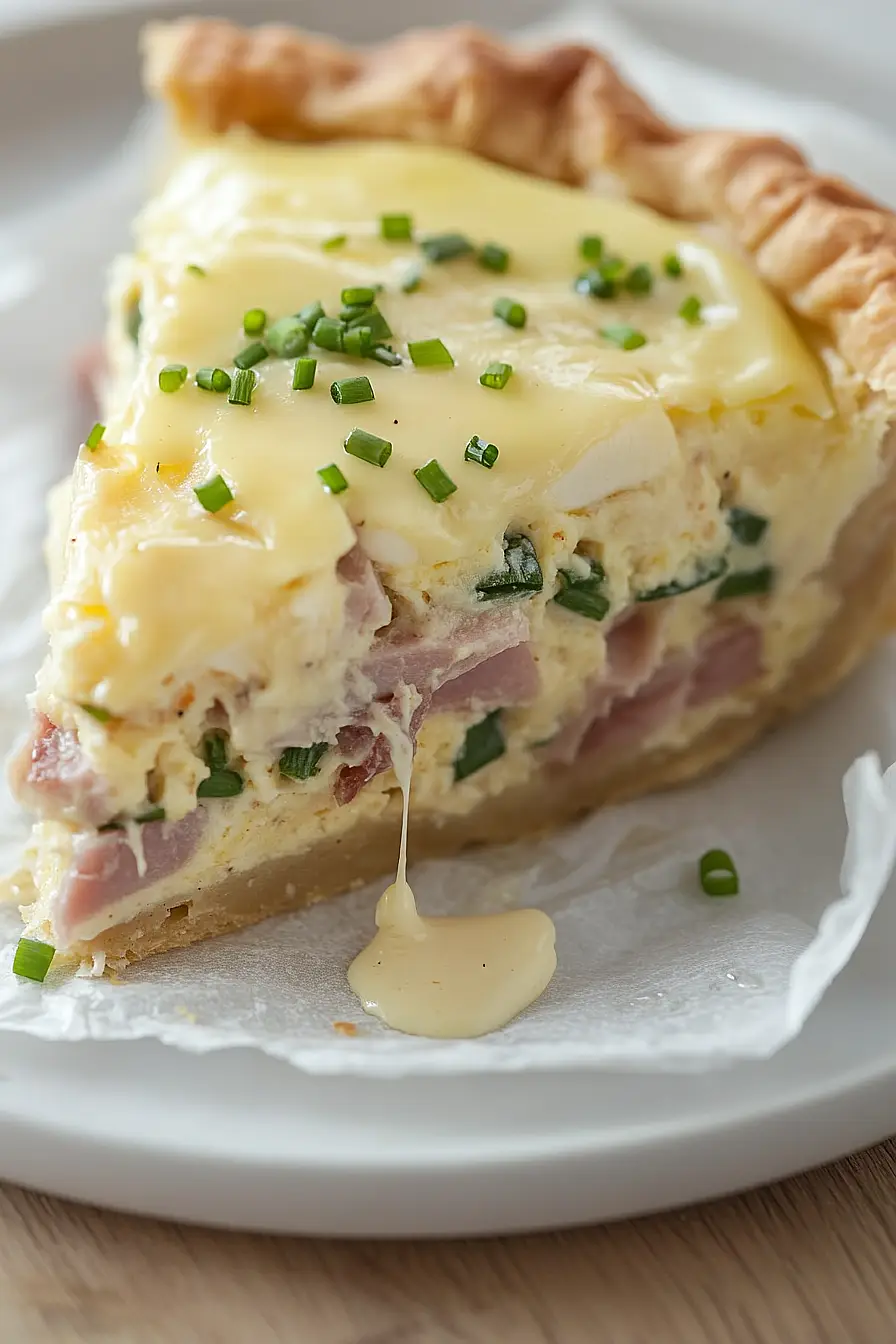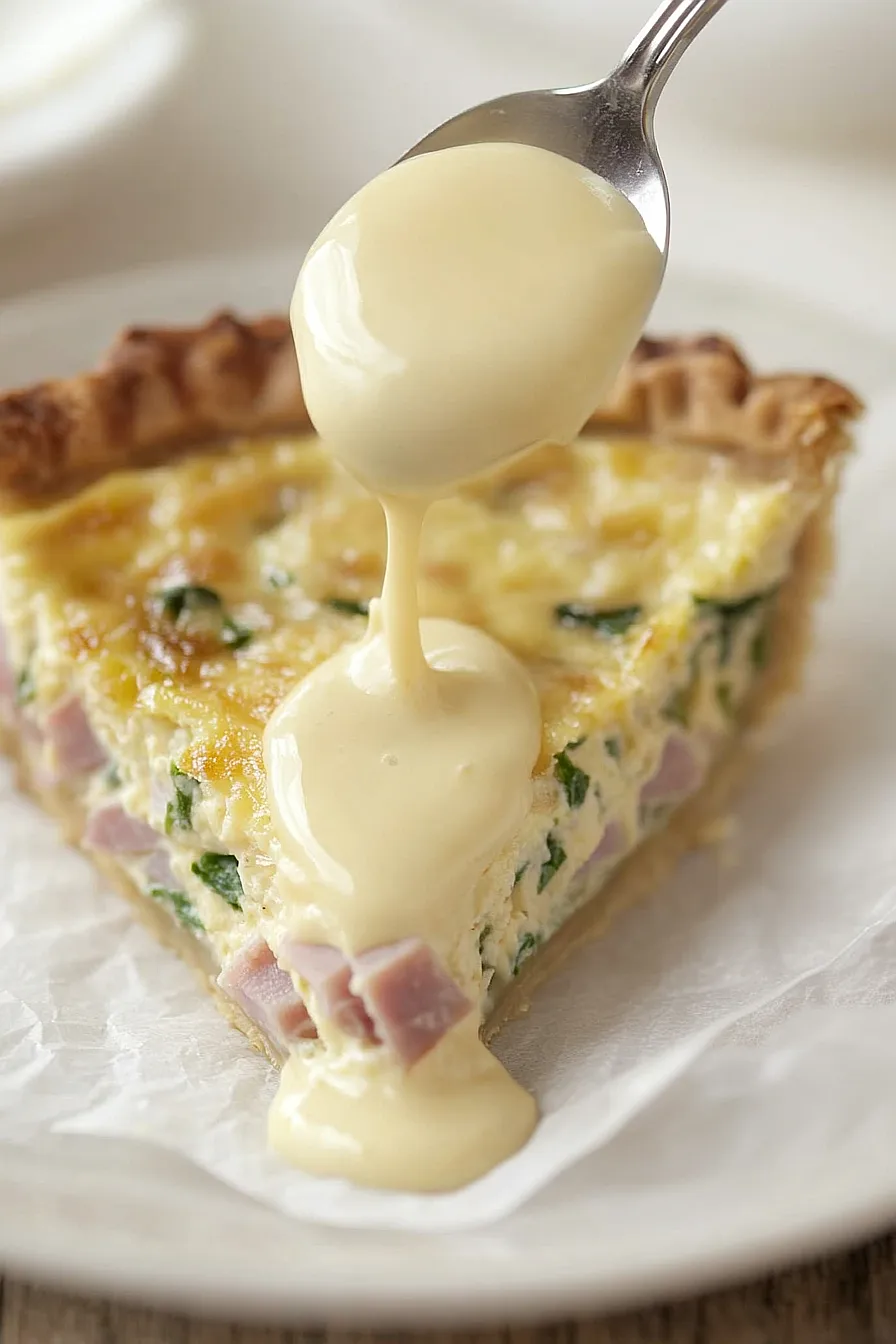Ever wanted to make eggs benedict for a crowd without the stress of poaching individual eggs and timing everything perfectly? I had the same struggle when hosting weekend brunches, especially when trying to serve everything hot and fresh at the same time. Between coordinating the hollandaise sauce and keeping those English muffins crispy, it was always a bit of a juggling act.
That’s where this eggs benedict quiche comes in – it takes all those classic flavors we love and turns them into a stress-free dish you can make ahead. Plus, the hollandaise sauce can be prepared while the quiche bakes, making the whole process so much more manageable for both casual family breakfasts and special gatherings.
Why You’ll Love This Eggs Benedict Quiche
- Make-ahead friendly – You can prepare this quiche the night before and reheat individual slices whenever you’re ready to serve – perfect for busy mornings or weekend brunches.
- Classic breakfast flavors – All the beloved tastes of traditional Eggs Benedict – creamy hollandaise, savory ham, and eggs – come together in an easy-to-serve pie form.
- Stress-free entertaining – No need to poach eggs for a crowd or time everything perfectly – this quiche gives you all the fancy brunch vibes without the pressure of last-minute preparation.
- Time-saving shortcuts – Using a pre-made pie crust and simple ingredients means you can skip several steps while still getting that restaurant-quality taste.
What Kind of Eggs Should I Use?
For this quiche, regular large chicken eggs from the grocery store will work perfectly fine – no need to get fancy here. Fresh eggs will give you the best results, so check the date on your carton and try to use ones that aren’t close to expiring. Since this recipe calls for both whole eggs and egg yolks (for the hollandaise), you’ll want to make sure your eggs are at room temperature before starting – this helps them blend better and cook more evenly. If you’re pulling them straight from the fridge, just let them sit on the counter for about 30 minutes before you begin cooking. And here’s a helpful tip: when separating your eggs for the hollandaise, it’s easier to do it when they’re cold, so separate them first, then let them come to room temperature.
Options for Substitutions
This quiche recipe is pretty adaptable and here’s what you can swap out if needed:
- Pie crust: While a frozen crust is convenient, you can use a homemade pie crust or even try a hash brown crust for a fun twist. For a low-carb option, you can skip the crust entirely and just grease your pie dish well.
- Half-and-half: Feel free to use whole milk, heavy cream, or any combination of the two. For a lighter version, 2% milk works too, though the filling won’t be quite as rich.
- White cheddar cheese: Regular yellow cheddar works just fine here. You could also try Gruyere or Swiss cheese for a more traditional Eggs Benedict flavor.
- Canadian bacon/ham: These are pretty interchangeable. You could also use regular bacon (cooked and crumbled) or even smoked salmon for a different spin.
- Green onions and chives: If you’re out of either, you can use all of one or the other. Regular onions (finely diced and sautéed until soft) can work in place of green onions.
- Hollandaise ingredients: The egg yolks and butter are essential for real hollandaise sauce – these shouldn’t be substituted. However, you can use bottled lemon juice if fresh isn’t available, and regular yellow mustard can work in place of Dijon.
Watch Out for These Mistakes While Baking
The trickiest part of this recipe is getting the hollandaise sauce just right – if you add the melted butter too quickly or let the sauce get too hot, it can separate or become lumpy. To prevent this, whisk the egg yolks constantly while adding the butter in a very slow stream, and keep the heat low if using a double boiler method. Another common mistake is overbaking the quiche – you want to pull it out when it’s still slightly jiggly in the center (around 165°F), as it will continue cooking from residual heat and firm up as it cools. To avoid a soggy bottom crust, try blind baking your pie crust for about 10 minutes before adding the filling, and make sure to place the quiche on the bottom rack of your oven. For the best texture, let the quiche rest for 15-20 minutes before slicing – this allows the eggs to set completely and makes for cleaner, more beautiful slices.
What to Serve With Eggs Benedict Quiche?
Since this quiche is already packed with rich, breakfast-inspired flavors, I like to balance it out with some lighter sides. A simple mixed green salad with a light vinaigrette adds freshness and cuts through the richness of the hollandaise sauce. Fresh fruit like berries or melon chunks work great on the side, especially if you’re serving this for brunch. If you want to lean into the breakfast vibe, crispy hash browns or roasted breakfast potatoes make excellent companions – they’re perfect for soaking up any extra hollandaise sauce that might be on your plate!
Storage Instructions
Keep Fresh: Once your quiche has cooled completely, wrap it well or pop it in an airtight container. It’ll stay good in the fridge for up to 3 days. I recommend storing the hollandaise sauce separately in its own container – it’ll keep for about 2 days in the fridge.
Freeze: The quiche (without the hollandaise) freezes really well! Wrap it tightly in plastic wrap and then foil, and it’ll keep in the freezer for up to 2 months. Just remember that hollandaise sauce doesn’t freeze well, so it’s best to make that fresh when you’re ready to serve.
Reheat: To warm up your quiche, cover it with foil and pop it in a 325°F oven for about 15-20 minutes. If it’s frozen, let it thaw overnight in the fridge first. For the hollandaise, gently warm it in short bursts in the microwave, stirring between each burst, or use a double boiler on low heat.
| Preparation Time | 15-20 minutes |
| Cooking Time | 50-60 minutes |
| Total Time | 65-80 minutes |
| Level of Difficulty | Medium |
Estimated Nutrition
Estimated nutrition for the whole recipe (without optional ingredients):
- Calories: 1800-2100
- Protein: 80-90 g
- Fat: 130-150 g
- Carbohydrates: 100-110 g
Ingredients
- 1 frozen deep-dish 9-inch pie crust (such as marie callender’s)
- 6 large eggs
- 1/2 cup half-and-half (or milk, or a mix of milk and cream)
- 1 cup grated sharp white cheddar cheese
- 3 tablespoons grated parmesan cheese
- 3 green onions, finely sliced
- 3 tablespoons chopped chives
- 1/4 teaspoon salt
- Fresh black pepper to taste
- 5 ounces diced ham or canadian bacon
- 3 large egg yolks
- 1 tablespoon lemon juice
- 1/4 teaspoon dijon mustard
- 1/2 cup melted unsalted butter
- Salt to taste
Step 1: Prepare the Oven and Pie Plate
Preheat your oven to 350°F (175°C).
Lightly spray a pie plate with non-stick spray.
This will help prevent the quiche from sticking to the plate after baking.
Step 2: Mix the Egg Filling
In a food processor, whisk, or using a hand-held beater, blend together the eggs with the half & half until completely combined.
Ensure there are no streaks of egg yolk or white.
Stir in your choice of cheeses, onions, chives, ham or bacon, along with a pinch of salt and pepper to taste.
Make sure the ingredients are well incorporated.
Step 3: Prepare the Crust and Pour the Filling
Gently remove the frozen crust from its original tin and place it in your prepared pie plate.
If you prefer, you can leave the crust in its original tin.
Place the pie plate on a baking sheet to help transfer it to the oven easily and catch any spills.
Pour the egg mixture into the frozen crust, spreading everything evenly, and ensuring a few hints of meat are visible at the top.
Step 4: Bake the Quiche
Bake the quiche in the preheated oven for about 50 minutes, or until it has puffed slightly and turned golden brown.
The center should be just set.
You can test it with a toothpick inserted in the center; it should come out clean or with just a bit of egg custard clinging to it.
Step 5: Cool and Serve
Let the quiche cool for at least 15 minutes before slicing.
This cooling period helps the quiche set further and makes slicing easier.
Step 6: Make the Hollandaise Sauce
To prepare the hollandaise sauce, place the egg yolks, lemon juice, and mustard in a blender.
Turn on the blender to combine the yolks.
Slowly drizzle in the hot melted butter while the blender is running.
The sauce should thicken as you pour in the butter.
If it becomes too thick, thin it with a bit of warm water.
Add salt to taste.
Step 7: Reheat and Serve Hollandaise
You can gently reheat the hollandaise sauce in the microwave.
Start with 15 seconds and stir well in between bursts, heating in short increments to avoid overheating.
Serve the warm hollandaise sauce over your cooled and sliced quiche for a delicious finish.


